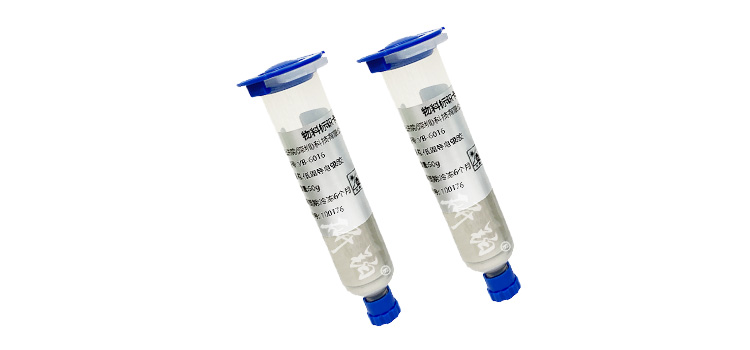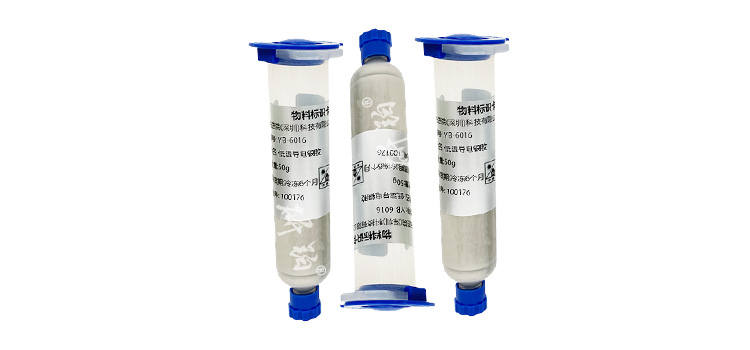With the trend of electronic devices developing towards miniaturization and high performance,
Low temperature conductive silver adhesiveAs a key electronic packaging material, the design of its high conductivity performance is crucial. It not only needs to meet the requirement of curing at lower temperatures, but also ensure good conductivity in various complex working environments. So, what are the key factors in the design of low-temperature conductive silver paste with high conductivity?
Characteristics and Selection of Silver Powder
Silver powder, as the main conductive component of low-temperature conductive silver paste, plays a decisive role in determining its conductivity. Firstly, the particle size of silver powder is crucial. Generally speaking, silver powder with smaller particle size can provide more conductive pathways and increase the efficiency of electron transfer. For example, silver powder with an average particle size of 1-3 microns can form a more dense and uniform conductive network in the silver gel, effectively reducing resistance. However, a particle size that is too small may also cause silver powder agglomeration, which in turn hinders conductivity, so precise control of the particle size range is necessary.
Secondly, the shape of silver powder can also affect its conductivity. The silver powder, which is approximately spherical in shape, has good fluidity and is more easily dispersed uniformly during the mixing process, which is conducive to the formation of continuous conductive channels. In contrast, irregularly shaped silver powders may experience a decrease in conductivity due to insufficient overlap between them.
In addition, surface treatment of silver powder is also crucial. By special surface treatment, organic ligands can be coated on the surface of silver powder to reduce its surface energy and prevent silver powder from aggregating in the silver gel system. At the same time, this treatment can enhance the compatibility of silver powder with solvents and resin matrix, ensuring stable dispersion of silver powder in silver gel and ensuring the stability of conductivity.

Adaptation of resin matrix
Resin matrix in
Low temperature conductive silver adhesiveIt plays a role in bonding and fixing silver powder, while also affecting the overall performance of silver paste. Choosing the appropriate resin matrix is crucial for achieving high conductivity. On the one hand, the resin matrix needs to have good low-temperature curing performance, which can quickly cure at lower temperatures without damaging electronic components, forming a stable structure. For example, some modified epoxy resins have their molecular structure adjusted to lower the curing temperature while ensuring the strength after curing.
On the other hand, the electrical properties of the resin matrix cannot be ignored. It should have a lower electrical resistivity to reduce interference with the conductivity of silver powder. In addition, the resin matrix needs to have good flexibility to adapt to the thermal stress generated by temperature changes during the operation of electronic devices, and to avoid microcracks at the interface between the silver adhesive and the adhered material caused by stress, which affects the conductivity performance.
Regulation of solvents and additives
Solvent is used in low-temperature conductive silver paste to adjust viscosity and facilitate construction operations. A suitable solvent system can provide a stable dispersion environment for silver powder, ensuring its uniform distribution during the mixing process. Multiple mixed solvents are usually used, such as high boiling point esters and low boiling point ketones, which work together to maintain good dispersion of silver powder in silver gel.
Additives are used to improve the specific properties of silver paste. For example, adding dispersants can enhance the dispersibility of silver powder. The customized polymer dispersant contains hydrophilic and hydrophobic groups. The hydrophilic groups interact with the ligands on the surface of silver powder, while the hydrophobic groups are compatible with the silver gel system, forming a stable coating layer on the surface of silver powder, effectively improving the dispersion effect of silver powder and thereby enhancing its conductivity. At the same time, some additives can also improve the adhesion and heat resistance of silver paste, indirectly having a positive impact on the stability of conductivity.

Optimization of solidification conditions
The curing time and temperature are important external factors that affect the conductivity of low-temperature conductive silver paste. If the curing time is too short, the silver particles in the silver paste cannot fully contact and connect, and the conductive network is incomplete, resulting in an increase in resistance and a decrease in conductivity. Moreover, a too short curing time may cause stress concentration inside the silver paste, resulting in microcracks and further deterioration of its conductivity.
On the contrary, a long curing time can cause excessive aggregation of silver particles, forming agglomerates and hindering the uniform distribution of the conductive network. Meanwhile, prolonged curing may cause excessive decomposition of organic components inside the silver paste, resulting in bubbles and voids, which also reduce its conductivity.
For the curing temperature,
Low temperature conductive silver adhesiveDesigned to cure at lower temperatures, typically around 150 ° C. Appropriate curing temperature can accelerate the contact and connection of silver particles, promoting the formation of conductive networks. However, excessive temperature can lead to excessive aggregation of silver particles and excessive decomposition of organic components, which in turn reduces conductivity. Therefore, determining the optimal curing time and temperature curve through extensive experiments, and strictly controlling the curing process, are necessary conditions for achieving high conductivity of low-temperature conductive silver paste.
The above data is for reference only, and specific performance may vary due to production processes and product specifications.






